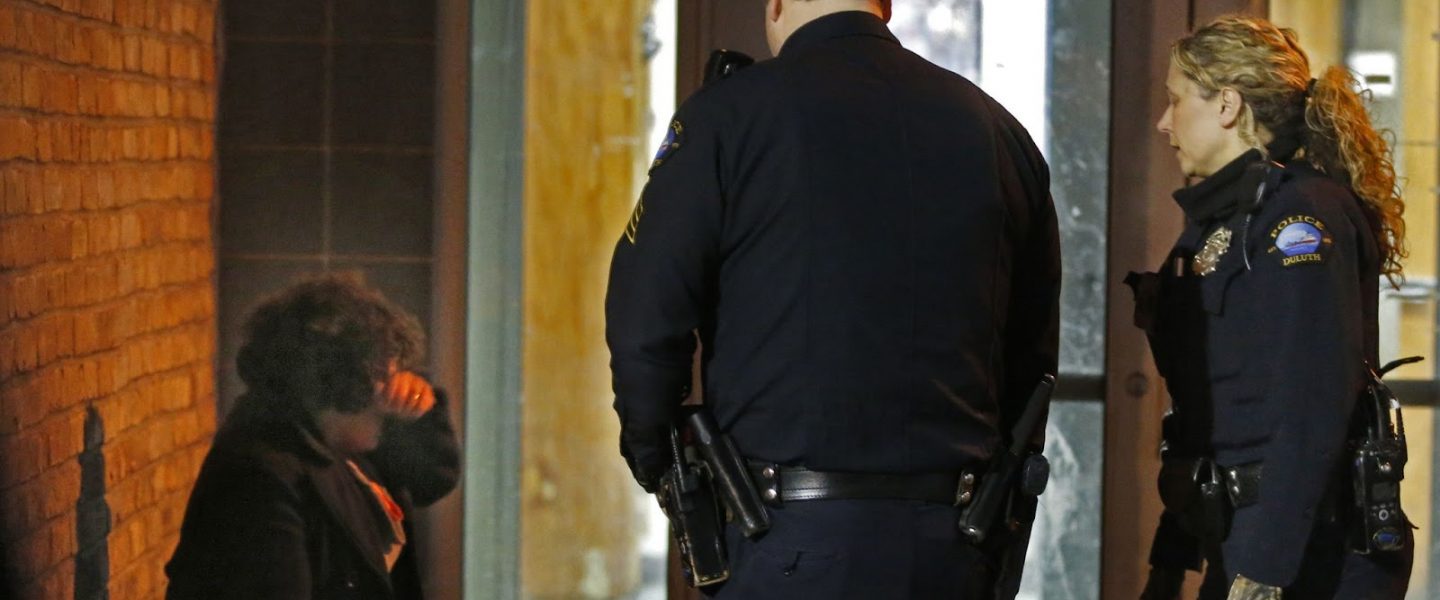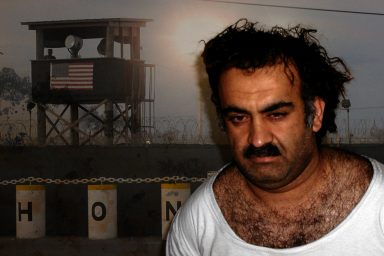Why America’s punitive and often violent response to those with mental illness makes our communities less safe and more inhumane.
People with mental illness are 16 times more likely to be killed by police in America than those who are mentally well. That’s a startling statistic offered by our guest on this week’s WhoWhatWhy podcast, but one that shows how punitive our response can be to those in need of psychiatric care.
As crime and homelessness once again come to dominate debate on the state of urban America, there’s little discussion on either the role of mental illness or society’s response to it.
If someone is in a physical accident, like a car crash, we send EMTs with lifesaving equipment and rush the victim to a hospital. If someone is suffering from mental illness and acting out or committing a crime, too often we send the police and lock them up. Or worse.
By doing this, says our guest, Dr. Christine Montross, we are actually jeopardizing the safety of our community for the short-term satisfaction of vengeance.
Montross is a psychiatrist and author of Waiting for an Echo: The Madness of American Incarceration. She argues that these cascading problems began as a well-meaning effort in the 1950s to deinstitutionalize the mentally ill, who were often held in inhumane conditions in mental institutions. When new classes of drugs, like Thorazine, came along, society decided that the mentally ill could be better treated outside of these institutions.
Except that, as Montross says, we never provided the funding or commitment to make this work. As a result, today the largest mental institution in the United States is the Cook County Jail.
We say our goal is safety and justice, but “what we are really good at is suffering and vengeance,” Montross says, explaining that the US has created a criminal justice system that is dehumanizing and degrading, and that people come back out into society worse than when they went in.
She shares with us “best practices” from other nations, and shows why she believes these can be successfully adapted to conditions in the US. Montross explains how we might actually change the culture of our prisons, why correctional officers also want it changed, and why it’s the only long-term solution to achieving safer communities.



Click HERE to Download Mp3
Full Text Transcript:
(As a service to our readers, we provide transcripts with our podcasts. We try to ensure that these transcripts do not include errors. However, due to a constraint of resources, we are not always able to proofread them as closely as we would like and hope that you will excuse any errors that slipped through.)
Jeff Schechtman: Welcome to the WhoWhatWhy podcast. I’m your host, Jeff Schechtman. No two subjects are more top of mind in urban America today, than crime and punishment and homelessness. Besides the political ramifications of both, the other thing they have in common is the way in which mental illness plays a central, but all too often neglected role in both. The federal government, along with many of our cities, are pouring billions into housing needs. We debate housing policy endlessly and seek solutions which often miss the problem entirely.
As for crime, we’re focused on the role of police, better police training, the role of race in police decisions, and again, we’re ignoring the mental health of the perpetrators. If mental health does become a part of either of these discussions, it’s usually an afterthought. Yet, as my guest, psychiatrist and author Christine Montross points out, it is mental illness that lies at the very core of both homelessness, crime, and punishment.
This isn’t a theory. Dr. Montross has seen all of this up close and personal and sees around the corners of where our current policy is headed. She has written extensively about this and covers it in her new book, Waiting for an Echo. Dr. Christine Montross is a Guggenheim fellow. She’s an associate professor of psychiatry and human behavior at Brown University as well as a practicing inpatient psychiatrist. She’s an award-winning poet and author, and it is my pleasure to welcome Dr. Christine Montross here, to the WhoWhatWhy podcast. Christine, thanks so much for joining us.
Dr. Christine Montross: I’m delighted to be here, Jeff. Thank you.
Jeff: It’s great to have you here. One of the things that I want you to talk about first is this frustration that you and your colleagues must feel that mental illness gets left behind as an issue within the context of so many of these broader issues that we talk about.
Christine: Yes. There’s no question and often to really tragic ends. The reason that I started writing Waiting for an Echo and looking into the prison and jail system to begin with, is that in my work as an inpatient psychiatrist, I was treating people with severe mental illness on the intensive treatment units at the hospital. These are the psychiatric equivalent of the ICU. People who are hearing voices, and seeing visions, are very paranoid, or actively trying to hurt themselves or other people. Over and over again, I would hear from my patients that they were coming in contact with police, and sometimes serving time in jails and prisons.
When I talked to them about what led to these legal encounters, almost always, the situations weren’t criminal intent. They were situations where their psychiatric symptomatology led them into police contact. They were shouting in the Starbucks or charging through TSA to try to get on a flight they had a delusional belief about, and in these moments, police were called. Our failure to treat their psychiatric symptoms and our quick response with policing and corrections struck me as really unjust.
Jeff: One of the statistics that’s quite remarkable is that mental illness, even more than race, really is responsible for more individuals being killed by police than anything else.
Christine: Well, we know that mentally ill people are 16 times more likely to be killed by police than people who are mentally well. Certainly, race complicates that as well, but that just gives an example of the real tragedy that can occur when people with psychiatric emergencies are seeking help and instead, they have a response that’s not therapeutic at all, but is rather punitive and sometimes quite dangerous.
One of the things that I think about in regard to that is how different that response is than one for other illnesses. If you’re in a car accident, or have a heart attack and you dial 911, the people who respond are trained clinicians. It’s a paramedic or an EMT who can start an IV, or administer oxygen, or stabilize a fracture, and transfer you to a medical facility. But when you have a psychiatric emergency, the first responders too often are police, and not trained clinicians. That’s a real discrepancy in how we treat mental illness as opposed to physical injury or illness.
Jeff: As you point out, the problem often starts before that. It’s not only police that are untrained in this. It’s the inability of families and loved ones, sometimes, of an individual, to get them the kind of help that they need.
Christine: I’m glad you raised that, Jeff, because the failures here, the blame for those failures don’t lie squarely on police. They lie broadly. As a society, we’re not providing adequate funding and support for people’s mental illnesses. It’s hard for people to obtain psychiatric treatment. Anyone who’s looked for their own therapist or psychiatrist knows that, and for those with severe mental illness, it’s even harder. We also have a real lack of psychiatric beds available in the country.
That’s only been exacerbated by the mental health stressors of the pandemic, but even prior to the pandemic. I talked with former police commissioner in Portland, OR, Sara Westbrook, who told a really poignant story that illustrated this quite well. She told the story of a man who was at the Portland waterfront, who was clearly mentally ill, who had a jug of fluid attached to a chain, and he was swinging it above his head and lunging at people, making people very scared. They called the police.
What she describes is that over a period of two hours, is that without using any force, the police got the man into their cruiser and were able to take him to the emergency room, but that there were no beds available for psychiatric patients. As Commander Westbrook describes, he was discharged from the emergency room before the police were even done with their paperwork. He returned to the waterfront, kept doing the same thing, police were called again. This time, they took him to jail. They knew that the jail had an ironclad no-refusal policy and at least there, he’d get treatment. That was a really stark example to me of how we fail to provide the therapies that people need who are mentally ill.
Jeff: Is it a stark example or has it gotten to the point, certainly in a lot of places, it has, gotten to the point where we’re using our jails and using the prison system as the first line of defense in dealing with mental illness?
Christine: Yes, you’re absolutely right. The largest psychiatric institution in our country is the Cook County Jail. That’s obviously not a treatment institution, but that place that holds the most mentally ill people in our country is the jail in Chicago. What I learned in talking with police officers, was that sometimes they’ll have this position of what they call compassionate arrest.
That when they see people who are mentally ill, they’ll say, “At least I know if they’re in jail, they’ll get three hots and a cot, they’ll have access to medication, and I’ll know that someone is checking to make sure that they’re breathing.” We would never arrest someone to make sure that they got their chemotherapy. We would never take someone to jail to make sure that they got their insulin for their diabetes. This is something we uniquely do for people with psychiatric illness, and in my mind, it’s incredibly unjust.
Jeff: How did we get to this point?
Christine: There’s a clear line here from the deinstitutionalization movements in the ‘50s, ‘60s, and ‘70s, which actually arose from quite altruistic aims. The psychiatric institutions of those eras, the state-run hospitals, often were places that were quite draconian, and suddenly, Thorazine was invented and for the first time, there was a medication that treated people’s voices and visions.
There was a desire to move mentally ill people out of institutions and back into the communities where they could receive treatment there in a less restrictive environment. The problem was that the funding that was necessary to support these mentally ill people in their community lives was never allocated. Suddenly, you had severely mentally ill people without housing, without food, without medication, and they were then sleeping in doorways and on park benches, begging for money, stealing items for subsistence.
Suddenly, this large group of people had shifted from the auspices of health care into the realm of criminal justice. We see, not a deinstitutionalization but actually what we’ve come to see is a trans-institutionalization. That as these psychiatric facilities were closed, people were indeed moved out of those facilities, but instead of being deinstitutionalized, they were just shifted from therapeutic institutions into punitive ones. Now, they’re housed within our jails and prisons and that pattern persists.
Jeff: Yet this has been the case for 50, 60 years now since that deinstitutional movement, and we still haven’t addressed it in any kind of fundamental way, or even acknowledged what the problem is.
Christine: In fact, we continue to cut funding for mental health. Part of this is due to the fact that for years, we have viewed addiction, something that we could have seen as a medical issue instead as a criminal issue, so our prisons are chock full of people who are there because of crimes of addiction, which is, of course, an illness. Part of it is our unwillingness to provide funds to support people who are severely mentally ill. You’re right. We know the problem. We see the problem, but there’s an aspect of our society that’s been willing to house our most vulnerable citizens in these facilities that are really not appropriate for them at all.
Jeff: Is the problem that there’s never been a clear alternative? It’s always been a band-aid solution, even in those communities, in those areas, that really sought to find some kind of a solution. It was always a band-aid solution. There’s never been a 30,000-foot view of what the alternatives are.
Christine: I think that’s partially the case. I also think it’s easy for people to distance themselves from people with severe mental illness, and similarly from detainees in prison. One of the projects in writing this book was how to get people to care what happens to people who are behind bars. I think that it’s easier to believe that everyone who winds up in prison deserves what happens to them, and we don’t have to worry too much about what conditions are like because those must be inherently bad people who are there. When in fact, when you slow down and look more closely, you see all kinds of people wind up in prison for reasons that have very little to do with evil in their souls.
That we see mentally ill people sent to prison, we see poor and racial minorities disproportionately sent to prison. There’s a chapter in my book, where I collect a group of white friends who list all the crimes they’ve ever committed, including felonies for which they’ve suffered no consequence with a clear awareness that there are people of racial minorities who are serving time in jails and prison for those very same crimes. I think it’s a comfortable illusion that we have, that we can lock people up and throw away the key and not worry too much about what happens to them when they’re there because they’re bad people, but of course, the truth is much more nuanced and more complicated than that.
Jeff: The practical truth is that 90-plus percent of them wind up back out of those prisons and back on the street, and sometimes in worse shape than when they went in.
Christine: That’s why our current approach is really short-sighted, in addition to being inhumane. You’re exactly right. 95 percent of detainees in America come back into our communities. One of the many problems with having a correctional system that’s dehumanizing and degrading, is that people come out of prison worse than when they went in. In Waiting for an Echo, I really focus on places that are doing this differently, with better results, lower recidivism rates, and preparing people to reemerge from prison more able to hold jobs, more able to connect with relationships, more able to pay taxes, and be good neighbors, and more apt to stay out of prison rather than to return.
Jeff: What are those other alternatives look like?
Christine: One of the most exciting places that I visited was Norway. Scandinavia takes a really different approach to incarceration, but they haven’t always done so. In the 1990s, their prison system looked a lot like ours. There was a great deal of violence within the prison. Their recidivism rate was similar to ours. It was about 68 percent. Ours ranges from 60 to 70 percent. They were not doing prison well, in their mind. They had a group of experts get together and decided to do things radically differently, and they’ve had really tremendous results.
The way that they describe it is really a philosophy shift. They say they stopped treating hard with hard and started treating hard with soft. What they mean by this, I think, is that they really let go of the idea that the purpose of prison is suffering and vengeance, and instead decided that every person who comes in should immediately receive and needs assessment. To look at what it was in their lives that led them to a situation where they ended up being incarcerated and the sentenced period, instead of the very American idea of just doing time, is focused entirely on addressing those deficiencies so that the person emerges less likely to re-offend when they leave.
If you need mental health treatment, substance abuse treatment, education, job training, anger management, those are the things that you get during the period of your sentence, so when you leave, you’re less likely to struggle with those issues. Their recidivism rate in Norway has dropped from 68 percent to 20 percent, so it means they’re also saving money in the long run, because people aren’t coming back to prison once they leave.
Jeff: What about the reality of bringing something like that to scale in this country?
Christine: I think it’s eminently possible. One of the frustrations of the American prison system is that each state runs their jails and prisons very differently, but that also provides a real opportunity so that a country like Norway is much smaller than a country like the US, but it isn’t much smaller than, say the city of Oslo is the same size as the city of Nashville. Their demographics are actually similar.
The discrepancy between our countries can feel enormous, but I think it’s actually overblown and there are state prison systems that are really trying innovative ways to do things differently, partially modeling themselves on Norway, and Sweden, and Germany, and other countries that are having better results in a more humane way.
Jeff: Isn’t the problem though, that the systems have gotten so large, even in these states and even in some of these cities that you’re talking about, that it has bred a certain kind of culture, and to transition to a different kinds of culture seems almost impossible.
Christine: I think there is a philosophical question that underlies all of this that you’re hinting at and that is, as a society, what do we believe the purpose is of our prison system? I think we say we want safety and justice, but when you look at the data over and over again, resoundingly, it shows that our current methods are not producing either of those things. Our communities are not more safe, our system is not more just. What we are really good at is suffering and vengeance.
But just like Norway had to release that as a primary goal, I think we too have to acknowledge that we can’t have both of those things. They’re mutually exclusive. We can’t want safer communities, and also want the people who are imprisoned to suffer. We have to let go of one of those things. I think we have a choice as to which one is more important to us. I think to this point, we’ve really doubled down on suffering and vengeance, but I think the logical, thoughtful person would acknowledge that that is certainly unkind to the people who are held up in prison, but it also serves our communities very poorly.
Jeff: Have we missed the opportunity for this, in that it might have been easier to address, to do these kind of things, or at least to even look at them seriously, within the context of a time when crime was going down? We’re at a time now when, whatever the reality might be, the perception certainly is, that crime is on the increase, there’s a lot more fear out there, and it would be a little like building a delicate watch inside of a boiler factory at this point.
Christine: We’ve missed lots of opportunities, but I don’t think that that limits the opportunities that are ahead of us. One of the interesting things about coming into a system as an outsider, into the prison system as a physician, is that sometimes one’s perspective is extremely different. One of the things that I really noticed is that in medicine, we are constantly performing risk assessments.
An example that I write about in the book is mammography. We know that there are young women every year who will get breast cancer and may get very sick and even die from breast cancer and yet, we have recommendations that women don’t need mammography until they’re 40 years old. Absolutely, if we started mammography at age 20, we would catch some of these breast cancers and save a few women’s lives, but we have decided that it’s not worth, it doesn’t merit the expense, and the nuisance, and the anxiety of imaging all of those groups of people in order to prevent that small number of illness and death, as devastating as it would be.
We take that approach all the time in medicine. We make choices about what makes sense logically, and economically, and we try to assess risk moving forward. In psychiatry, we do that all the time. When we decide who to discharge from the hospital and who’s safe to go. In prison, we really don’t do that. We don’t acknowledge that we should release a good number of people from our prison system, even if it means one or two of them may commit a crime again. Instead, we err on the side of locking up too many people for too long, to avoid any bad outcome altogether, without acknowledging that it’s a bad outcome to keep people locked up who don’t need to be there any longer.
Jeff: One of the differences between mental and physical illness that you often hear is that with physical illness, in many cases, you can think about somebody getting well. You can think about them being cured or recovered from that proverbial accident that you referenced before. With mental illness, we don’t think about it in those kind of binary terms. Talk about that.
Christine: Well, mental illness in multifactorial so often that there’s something very different about illnesses of the mind than there is, say about clearing a blockage in an artery. You can’t image an image of the mind and understand quite what’s there. You can’t operate on a psychiatric condition and fix whatever is unsteady at the moment and yet, what I see over and over again in my practice, is people who come in sick leave far more well. People who learn to lead incredibly stable, happy, fulfilling lives despite the fact that they have a mental illness.
I think that we do a disservice to people with mental illness when we cast those illnesses as incurable or unalterable, but instead to recognize that we do have promising treatments. We have treatments that help people live stable and fulfilling lives. Some of those are medications. Some of those are therapeutic interventions. Some of them are lifestyle interventions. But people are really able to live happily, and in a fulfilled way with mental illnesses, and that’s a story that is important to tell.
Jeff: There’s so much talk about the crimes themselves, and whether mental illness then becomes an excuse for crime, particularly when that’s brought together with drugs and addiction. Talk about that.
Christine: In my experience, that seems to be more of a Hollywood focus than a real-life focus. I think the idea of a person who claims mental illness to get off of a charge or tries to feign mental illness in order to evade responsibility is not something, in fact, that I’ve ever seen. What I’ve seen far more often is people with mental illness who are committing low-level crimes, or who, in the rare event that they do commit horrific crimes, often have to deal with the consequences for the whole rest of their lives once they come into a space where they understand what they have done.
The other really critical thing to understand, I think we have this idea of people who plead not guilty by reason of insanity and then get off scot-free. In fact, a tiny percentage of people plead not guilty by reason of insanity. Of those, less than 1 percent are successful in receiving that judgment. When people are deemed not guilty by reason of insanity, they don’t go free. They go to a psychiatric hospital, a locked forensic hospital for a period of time where they receive continued assessment and observation.
Sometimes they are in the hospital far longer than they would have been had they received the maximum sentence for their crimes. So, I think this idea that mental illness allows people an escape route is really a fabricated fiction.
Jeff: It’s hard to imagine that the current staffing, this gets back to the whole culture issue, I suppose, the current staffing of America’s jails and prisons would be receptive to these ideas.
Christine: That was one of the most fascinating elements of researching Waiting for an Echo for me, and that was that these environments are just as difficult for the people who work within them, as for the people who are held within them. The job of correctional officers is an incredibly demanding, difficult job. The suicide rate of correctional officers is higher even than police or members of the military. When you think about how many of us have had a professional situation with an adversarial relationship, and how difficult that is to go in to work every day, the entire arrangement in our prison system is an adversarial setup between the officers and the detainees. That is a really hard environment.
Just earlier today, I was on a call-in show and a correctional officer called in and he said everyone who is in that environment, works and lives in that environment. “We get to go home, but we take it home with us.” He was saying how difficult it is to exist in an environment like that. What we’ve seen in places like Sweden and Norway is actually the redefinition of the role of the correctional officer, to align more with one of a social worker, or a nurse, or your assigned detainees that you get to know, that you have these collaborative, allied relationships, and you focus together on the future for the detainee.
How did they come to this place? How are they going to use their time in prison? Where are they going in the future once they leave? The correctional officers report significantly higher job satisfaction and a significant reduction in aggression and violence toward correctional officers when these relationships are more collaborative.
Jeff: In the countries like Norway that have pivoted to this approach, how did they begin?
Christine: I asked that very same question in doing my research and got some answers that really made me laugh, because people matter-of-factly said, “Well, we just asked the experts. We asked the experts to get together, and make a white paper, and determine what would be better practices. Then the experts brought those to our politicians and our politicians implemented them and put them in place.” I thought that, in and of itself, is a slightly foreign concept for those of us in America. The idea that scientists and academics would get together and come up with a solution and present it to the policymakers who would then just implement it.
We talked a great deal about the difference in America, and how issues of public policy sometimes become quite political — scientific issues become quite political —and even with morality attached in a way that’s not necessarily true in other places. I think that they started from a place that was very analytical. The question is, can we, in America, get to that analytical place if we understand that it behooves us to do so?
Jeff: Looking at the reality today, what, if anything, gives you optimism for this?
Christine: I think this idea of when hardly anything is bipartisan, that there’s bipartisan agreement, that we need prison reform is incredibly hopeful for me. I think this idea that we don’t have to reinvent the wheel, that there are places that are doing this that we need only look to to make change. I think that the pandemic has offered a rare moment of empathic understanding for those of us who live free lives, as to the psychological damage that social isolation brings about.
I think that all of us suffered depression and anxiety to some degree when we were separated from our friends and family members, when we couldn’t go to the bedsides of loved ones who were ill, or the funerals of loved ones who had died. When we couldn’t see parents and grandparents, children and grandchildren, we all felt the repercussions of that. I think that gives us a glimpse of what we do to people when we incarcerate them, and the damage that that incurs, and that can motivate people to change their understanding and that’s my hope.
Jeff: Dr. Christine Montross. Her book is Waiting for an Echo: The Madness of American Incarceration. Christine, I thank you so much for spending time with us today.
Christine: I enjoyed it. Thanks for the thoughtful questions, Jeff.
Jeff: Thank you, and thank you for listening and joining us here on the WhoWhatWhy podcast. I hope you join us next week for another Radio WhoWhatWhy podcast. I’m Jeff Schechtman. If you liked this podcast, please feel free to share and help others find it by rating and reviewing it on iTunes. You can also support this podcast and all the work we do by going to whowhatwhy.org/donate.



